#tecumseh
Explore tagged Tumblr posts
Photo
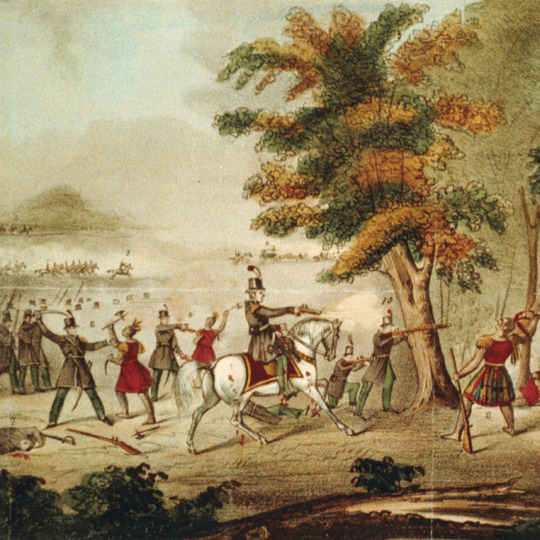
Battle of the Thames
The Battle of the Thames (5 October 1813), or the Battle of Moraviantown, was a decisive engagement in the War of 1812, in which a US army under General William Henry Harrison defeated a British and Native American force in Upper Canada. The battle resulted in the death of the Shawnee chieftain Tecumseh and the dissolution of his intertribal confederacy.
Battle of the Thames
William Emmons (Public Domain)
Background: The Struggle for Michigan
On 16 August 1812, less than two months after the War of 1812 had been declared, the British captured the major US outpost of Fort Detroit without a fight, giving them control of the entire Michigan Territory. This decisive victory could not have been achieved without the help of several northwestern Native American nations, who had sided with the British in order to resist the aggressive westward expansion of the United States. Under the charismatic leadership of the Shawnee chieftain Tecumseh, these Native American nations were in the process of joining together in a new intertribal confederacy, with the goal of recovering lands they had lost to the US after the disastrous Battle of Fallen Timbers (20 August 1794). Britain was eager to support this new confederacy, viewing it as a potential buffer state between the US and Canada, and promised to help set up the Native Americans on lands west of the Ohio River.
The United States, anxious as it was to prevent a hostile, British-backed Native American confederacy from arising on its western frontier, was determined to nip the threat in the bud by reconquering Michigan. This task was allotted to Major General William Henry Harrison, the popular hero of the Battle of Tippecanoe, and his newly formed Army of the Northwest, comprised mainly of volunteers from Kentucky and Ohio. In early October 1812, Harrison set out towards Detroit, but his progress was hindered by poor logistics and bad weather. Forced into winter quarters by January 1813, Harrison faced additional difficulties when the leading column of his army – at the small settlement of Frenchtown, Michigan, on the River Raisin – was attacked and defeated by a British and Native American force. After the battle, the British soldiers withdrew to Detroit, taking their able-bodied captives but leaving behind those Kentuckian prisoners who were too wounded to walk. When night fell, many of these wounded Kentuckians were massacred by Potawatomi warriors allied with the British, who desired vengeance for their villages that had been burned by Harrison's army during its advance through Ohio.
Harrison, upon learning of the defeat at the Battle of the River Raisin, withdrew the rest of his army to the Maumee River, where he hastily built Fort Meigs in February 1813. For the next several months, the Army of the Northwest remained holed up in the fort, even withstanding a brief siege in May. Before he could continue his advance toward Detroit, Harrison knew that the Americans needed to gain control of Lake Erie; possession of the lake would allow them to more easily reinforce and resupply their army in Michigan. With this goal in mind, the Americans built nine vessels on the lake, which were placed under the overall command of Master Commandant Oliver Hazard Perry.
The Battle of Lake Erie
Julian Oliver Davidson (Public Domain)
In late August, Perry moved his naval squadron to Put-in-Bay, Ohio, a position from which he could blockade the main British outpost along the lake, at Amherstburg in Upper Canada (present-day Southern Ontario). A squadron of six British ships, under Robert Heriot Barclay, sailed out to meet this threat, culminating in the Battle of Lake Erie (10 September 1813), in which Perry prevailed, capturing the British vessels; as Perry himself would put it in his report to Harrison, "We have met the enemy and they are ours." With the Americans in control of Lake Erie, Harrison was free to resume his advance toward Detroit. In mid-September, his army marched into Michigan along the lakeshore, supplied by Perry's victorious ships in the lake.
Continue reading...
29 notes
·
View notes
Text
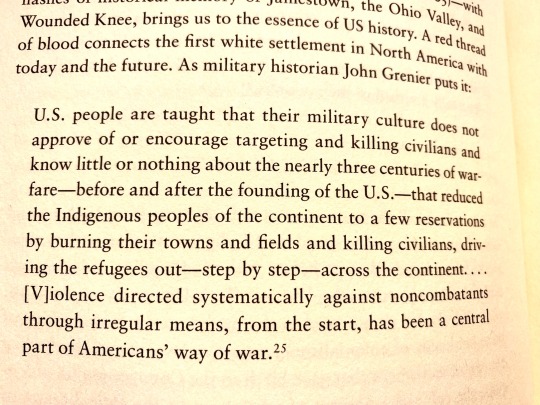
“U.S. people are taught that their military culture does not approve of or encourage targeting and killing civilians and know little or nothing about the nearly three centuries of war-fare-before and after the founding of the U.S.-that reduced the Indigenous peoples of the continent to a few reservations by burning their towns and fields and killing civilians, driving the refugees out--step by step--across the continent....Violence directed systematically against noncombatants through irregular means, from the start, has been a central part of Americans' way of war. “
Military Historian John Grenier
Excerpt from Roxanne Dunbar-Ortiz’s book:
An Indigenous People’s History of the United States
#us history#wounded knee#sand creek#trail of tears#the long walk#bear river#thanks taking#in Country#🇺🇸#land back#crazy horse#tecumseh#sitting bull#Geronimo#chief joseph#emiliano zapata#Joaquin murrieta#Pó Pay#captain Jack#war crimes#enthic cleansing#Roxanne Dunbar Ortiz#american history
283 notes
·
View notes
Text

Broadway Street, Tecumseh, Nebraska.
52 notes
·
View notes
Text

Snoopy on Ice
Seen in Tecumseh, Michigan.
6 notes
·
View notes
Text






2 OF 2
#settler colonialism#thanksgiving#turtle island#indigenous#Pueblo Revolt of 1680#know your history#geronimo#sitting bull#pontiac#tecumseh#non violent resistance#ethnic cleansing#genocide#1936 Palestinian Revolution#save palestine#apartheid#free palestine 🇵🇸#Palestinian protests#boycotts work#boycott divest sanction#indigenous solidarity#whitewashing genocide#First Nation Americans#Native Organizers Alliance#consumer strike for palestine#indigenous rights#solidarity#settler colonialism has been been behind countless lives and lands stolen#propaganda kills#educate yourself
5 notes
·
View notes
Text
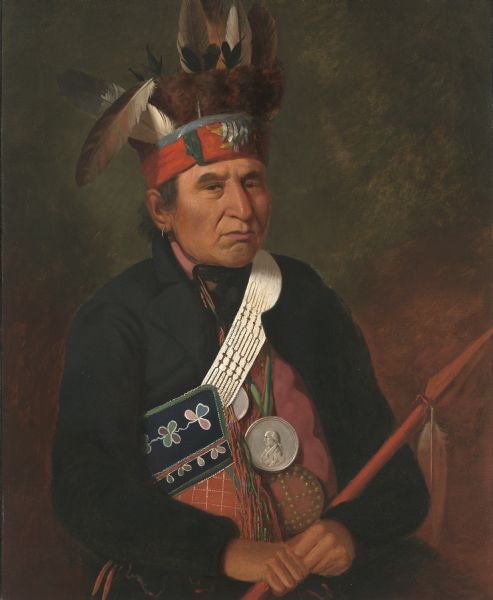
A portrait of Chief Souligny of the Menominee (Wisconsin Historical Society). Undated, but credited to the English-born American artist Samuel Marsden Brookes (1816-1892).
I can't find any information about Souligny other than what the Wisconsin Historical Society provides: that he was named after his French great-grandfather, and he was an ally of Tecumseh who sided with the British in the War of 1812. He later changed his loyalty to the United States, and he is shown wearing a James Madison Peace Medal.
Yesterday I picked up Tecumseh and the Prophet: The Shawnee Brothers Who Defied a Nation by Peter Cozzens from the library. I'm currently reading the section in the book about the battle for Fort Meigs, which is eye-opening. But there's nothing in the book's index about Chief Souligny. Maybe he was a very minor figure in Tecumseh's confederacy, I don't know.
It's frustrating and it feels like a symbol of how hard it is to learn the specifics of Indigenous participation in the War of the 1812: and there was a lot of it, especially on what was then the northwestern frontier of the United States. Many First Nations allied with the British against the expansion of US settlements, and in many War of 1812 battles there are a substantial number of Indigenous warriors, who are sometimes in the majority with British regulars and USAmerican army or militia as the other forces.
There are yearly reenactments of the Siege of Prarie du Chien in the War of 1812, but if you look up pictures you won't see any Menominee, Ho-Chunk, or Meskwaki—who were the vast majority of participants. If they're present they never seem to be in the photos.
#war of 1812#chief souligny#menominee#indigenous#samuel marsden brookes#tecumseh#fort meigs#military history#us history#wisconsin#i almost went to the native american museum in the wisconsin dells#but apparently it's just a tourist trap and gift shop#warof1812posting on a friday night
62 notes
·
View notes
Text
Tecumseh, the Indian: His Majestic Poetry (Essay)

imaginary drawing
This is a poem by Tecumseh at the end of the movie "Navy Seals".
・・・・・・・・・・・・・・・・・・・・・・・・・・・・・・・・・・・・・・・・・・・・・・・・ ・・・・・・・・・・・・
live a life free from the fear of death
don't undermine people's beliefs
Respect other people's ideas and ask them to respect yours
love life and live it to the fullest
Make everything beautiful
Try to live long and devote yourself to the people you care about
and when the time comes
Don't be a prisoner of the fear of death
I need more time
Don't be the one who laments that you want to start over with a different life
hum a hymn
Die like a hero returns
I think it's a majestic poem that doesn't defile the dignity. In a short poem, one vision of life is concentrated. He also has a clear view of life and death. Who can write a poem like this...?
Below, from wikipedia
@@@@@@@@@@@@@@@@@@@@@
Tecumseh or Tecumtha (Tekamthi, 1768? – October 5, 1813) was an American Indian warrior or chief of the Shawnee tribe, and a symbol of the colonial resistance movement against the whites.
The only way to stop this evil, the invasion of the white men, is for the Indians to band together and claim common and equal rights to the land. Land was never divided before. It belongs to all of us Indians.
No Indian tribe has the right to sell land, even among the same tribe. Moreover, they absolutely do not have the right to sell to white people who have come from outside.
@@@@@@@@@@@@@@@@@@@@
The last few lines are from Tecumseh's speech.
Sociologist Max Weber, famous for ``Protestant ethics and the spirit of capitalism,'' read the Analects (Book on Confucius’s saying and deed) and said, ``This way of speaking resembles an Indian chief.'' … Well, from the European perspective, I think both are the same, with the underlying meaning that white people are free to control and persecute.
9 notes
·
View notes
Note
Have you heard of Curse of Tippecanoe?
Yes (although I've always called it "Tecumseh's Curse"). In fact, one of the early pieces of writing that I published on this blog was about "Tecumseh's Curse". Here is that post -- which I cleverly titled "Tecumseh's Curse" -- from January 16, 2010 (!).
(I can't believe I've been writing about Presidents on Tumblr for over 15 years.)
#Presidents#History#Tecumseh's Curse#Curse of Tippecanoe#William Henry Harrison#Presidency#Presidential Superstitions#Presidential Urban Legends#Tecumseh
5 notes
·
View notes
Photo

Chibi Practice
If you want to see more like this please support me at Subscribestar / Ko-Fi Last year I wanted to get some more practice drawing chibis, and at that time I was only having success drawing on paper. So I tried tricking me brain into thinking i was drawing on paper... it only sort of worked, but they came out cute. Please Enjoy! Art drawn by Me Art, and Characters belong to Hubby and I
Posted using PostyBirb
#Furry#Furry Art#Digital#Sketch#Dunn#Dunn Well#Male#Ranger#Barbarian#Nagaji#Dhampir#Tecumseh#Fox#Female#Kitsune#Magus#Kit#Kit Sunne#Human#Mona#Badger
4 notes
·
View notes
Video
Fawn in Stride by James Marvin Phelps Via Flickr: Fawn in Stride White-tailed Deer Bishop Gardens Tecumseh, Michigan August 2023
8 notes
·
View notes
Photo

Siege of Fort Meigs
The Siege of Fort Meigs (28 April to 9 May 1813) was a major engagement on the northwestern frontier of the War of 1812. It saw a US army under Major General William Henry Harrison, holed up in the hastily built Fort Meigs, withstand a siege by British and Native American forces despite heavy casualties.
Siege of Fort Meigs
D.W. Kellogg & Co. (Public Domain)
Background
On 16 August 1812, the US outpost of Fort Detroit surrendered to a British and Native American force after a brief and nearly bloodless siege. At a stroke, the British had seized control of the entire Michigan Territory, which they could now use as a staging ground for an invasion of western US states like Ohio or Kentucky. Even worse from a US perspective, the Siege of Detroit had emboldened several previously neutral Native American nations to side with the British and begin to attack US outposts and settlements. Many of these northwestern Native Americans had been driven from their lands by the US after the Battle of Fallen Timbers (20 August 1794) and were eager to reclaim what they had lost; indeed, the British promised to help the Native Americans set up their own, independent confederacy on lands west of the Ohio River. Such a confederacy would serve British interests by acting as a buffer state between Canada and the US.
The US was anxious to prevent a hostile, British-backed Native American confederacy from arising on its western frontier and knew that it had to balance the scales by retaking Detroit. Such an important task was entrusted to William Henry Harrison, the popular former governor of the Indiana Territory and the hero of the Battle of Tippecanoe (7 November 1811). Harrison was given the rank of major general and placed in command of the newly formed Army of the Northwest, comprised mainly of raw volunteers from Kentucky and Ohio serving six-month enlistments. In early October, this army set out from Fort Defiance in Ohio, but bad weather and poor logistics slowed its advance to a crawl. Before long, winter was setting in, and Harrison begrudgingly concluded that he would be unable to assault Detroit before spring. He ordered the advance column of his army, under Brigadier General James Winchester, to continue marching to the Maumee Rapids (near present-day Toledo, Ohio) where they would begin setting up camp for the winter.
Winchester's men arrived at the Maumee Rapids in mid-January 1813. Having been on the march for weeks by this point, most of these men were cold, wet, and hungry; many of their enlistments were about to expire, and they longed to fight a battle before being sent home if only to make their long miles of miserable marching worth it. They would soon get an opportunity, as word reached their camp that a detachment of Canadian militia had occupied Frenchtown, a small community on the River Raisin in Michigan, and was harassing its inhabitants. The Americans begged Winchester to let them march to Frenchtown's rescue. Winchester, enticed by the prospect of an easy victory, relented and sent several companies of Kentuckians into Michigan.
The British-American War of 1812
Simeon Netchev (CC BY-NC-ND)
On 18 January, the Kentuckians easily routed the Canadians, causing an elated Winchester to move the rest of his column to Frenchtown as well. Once there, the inexperienced Americans grew complacent, neglecting to post adequate pickets or fortify their position. Therefore, the Americans were caught by surprise when a British and Native American force, under Sir Henry Procter, counterattacked just before dawn on 22 January. The Americans were defeated, and many were killed in the fighting. Of the survivors, those who could walk were taken across the Detroit River to Amherstburg as prisoners, while those too wounded to move were left behind in Frenchtown. That night, many of these wounded would be massacred by Potawatomi warriors allied with the British.
Continue reading...
18 notes
·
View notes
Text

Leonard Peltier is the longest held political prisoner in US history. He’s also a brilliant painter & author. Call your representatives and even Byron to demand he be pardoned 🪶
#leonard peltier#free leonard peltier#incident at Oglala#indigenous peoples#❤️🖤💛#crazy horse#Geronimo#sitting bull#tecumseh#AIM
5 notes
·
View notes
Text
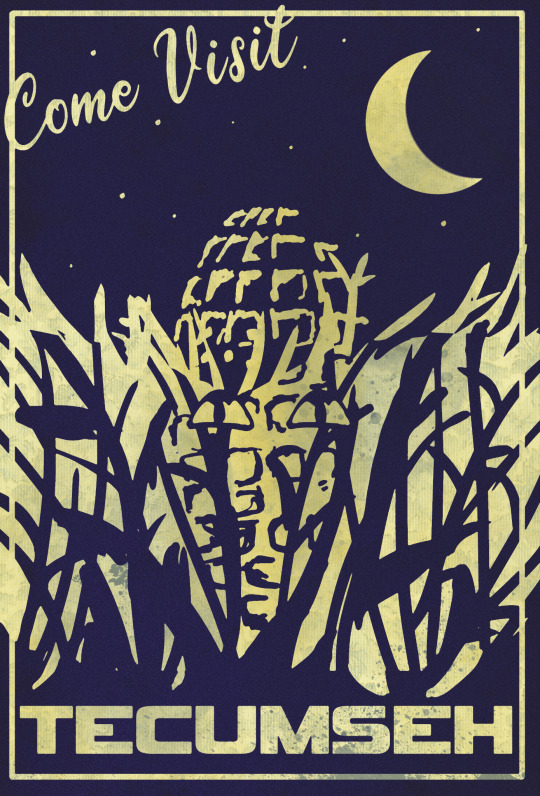
Was inspired by drawfees latest episode of making cryptids for their home town. Based off the mascot ofna local festival
4 notes
·
View notes
Text
Tecumseh
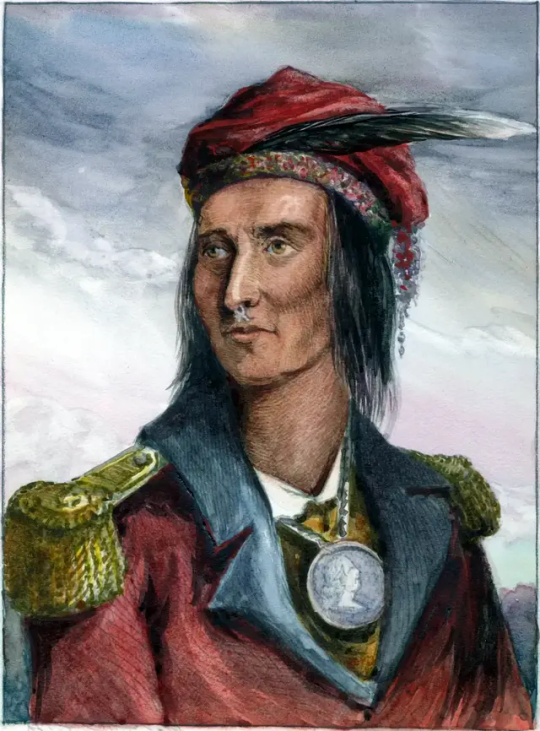
Tecumseh ⋆ Shawnee Häuptling ⋆ Leben und Legende
Tecumseh (1768 – 5. Oktober 1813) war ein Shawnee- Häuptling und Krieger, der gegen die Siedlungspolitik der Vereinigten Staaten auf dem Land der amerikanischen Ureinwohner Widerstand leistete. Indigene Geschichten besagen, dass Tecumseh nach einer Sternschnuppe benannt wurde, die bei seiner Geburt am Himmel erschien. Als überzeugender Redner reiste Tecumseh weit umher, gründete eine Konföderation der amerikanischen Ureinwohner und förderte die Einheit zwischen den Stämmen. Obwohl seine Bemühungen, die amerikanischen Ureinwohner zu vereinen mit seinem Tod endeten, wurde er zu einem ikonischen Volkshelden der amerikanischen, indigenen und kanadischen Volksgeschichte. Während Tecumseh am White River lebte, litten die amerikanischen Ureinwohner in der Region unter Krankheiten wie Alkoholismus, Armut, Landverlust, Entvölkerung und dem Niedergang ihrer traditionellen Lebensweise. Es traten zu dieser Zeit unter ihnen mehrere religiöse Propheten auf, die jeweils Erklärungen und Abhilfemaßnahmen für die Krise anboten. Unter diesen war auch Tecumsehs Bruder Lalawéthika, ein Heiler. Lalawéthika forderte seine Zuhörer auf, europäische Einflüsse abzulehnen, mit dem Alkoholkonsum aufzuhören und ihre traditionellen Medizintaschen wegzuwerfen. Tecumseh selbst folgte ebenfalls den Lehren seines Bruders, indem er nur einheimisches Essen aß, traditionelle Shawnee-Kleidung trug und keinen Alkohol trank. Tecumseh wurde im heutigen Ohio geboren, zu einer Zeit, als sich die weit verstreuten Shawnees in ihrer Ohio Country Heimat wiedervereinigten. Während seiner Kindheit verloren die Shawnees aber eine Reihe von Grenzkonflikten. Tecumsehs Vater wurde dabei 1774 im Kampf gegen amerikanische Kolonisten getötet. Tecumseh wurde danach von seinem älteren Bruder Cheeseekau betreut, einem bekannten Kriegshäuptling, der auch 1792 im Kampf gegen die Amerikaner starb. Als junger Kriegsführer schloss sich Tecumseh sodann dem Shawnee Chief Blue Jacket bewaffneten Kampf an, weitere Vorstöße von amerikanischen Siedlern zu verhindern. Im Jahr 1805 gründete Tecumsehs jüngerer Bruder Tenskwatawa, der als Shawnee-Prophet bekannt wurde, eine religiöse Bewegung, die die amerikanischen Ureinwohner aufforderte, europäische Einflüsse abzulehnen und zu einem traditionelleren Lebensstil zurückzukehren. Im Jahr 1808 gründeten Tecumseh und Tenskwatawa sodann den Ort Prophetstown, ein Dorf im heutigen Indiana, das sich zu einer großen, multistämmigen Gemeinschaft entwickelte. Tecumseh selbst reiste weiter ständig umher und verbreitete die Botschaft seines Bruders. Er verkündete, dass die amerikanischen Ureinwohner ihr Land gemeinsam besaßen, und forderte alle Stämme auf, kein Territorium mehr abzutreten, es sei denn, alle würden zustimmen. Seine Botschaft alarmierte sowohl amerikanische als auch einheimische Führer, die eine Einigung mit den Vereinigten Staaten suchten. Im Jahr 1811, als Tecumseh im Süden Verbündete rekrutierte, besiegten die Amerikaner unter William Henry Harrison Tenskwatawa in der Schlacht von Tippecanoe und zerstörten auch den Ort Prophetstown. Im Krieg von 1812 schloss sich Tecumseh, seiner Sache wegen, den Briten an, rekrutierte Krieger und half im August 1812 auch bei der Eroberung von Detroit. Tecumseh führte etwa 530 Krieger an. Einem Bericht zufolge ließ Tecumseh seine Männer wiederholt in einen Wald aus- und eingehen, nur um den Eindruck zu erwecken, dass sich Tausende von amerikanischen Ureinwohnern außerhalb der Festung befänden. Einer der berühmtesten Vorfälle in Tecumsehs Leben ereignete sich nach der Schlacht. Amerikanische Gefangene waren zu einer nahe gelegenen Ruine gebracht worden. Als eine Gruppe Indianer begannen, Gefangene zu töten, stürmte Tecumseh herbei und stoppte das Massaker. Durch diese Tat der Verteidigung der amerikanischen Gefangenen wurde Tecumseh schließlich zu einem Eckpfeiler seiner Legende, dem ultimativen Beweis seines angeborenen Adels, wie es hieß. Als die US-Seestreitkräfte 1813 endlich die Kontrolle über den Eriesee übernahmen, zog sich Tecumseh widerstrebend mit dem Heer der Briten nach Oberkanada zurück, wo sie am 5. Oktober 1813 in der Schlacht an der Themse besiegt wurden. Hierbei kam auch Tecumseh ums Leben. Sein Tod führte zum Zusammenbruch seiner Konföderation und die Ländereien, für deren Verteidigung er ein Leben lang gekämpft hatte, wurden an die US-Regierung abgetreten. Tecumseh schließlich ging als einer der berühmtesten amerikanischen Ureinwohner in die Geschichte ein und sein Vermächtnis steht bis heute.
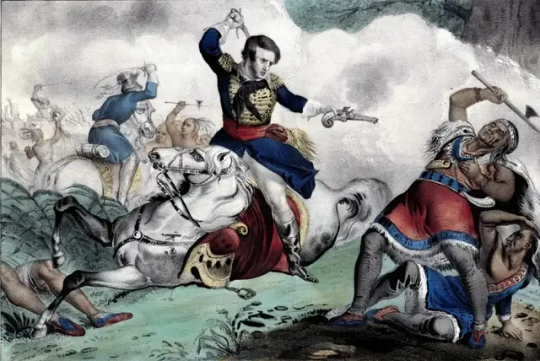
Tecumseh ⋆ Shawnee Häuptling ⋆ Leben und Legende - Tod Read the full article
2 notes
·
View notes
Text

Cold Gnome
See in Tecumseh, Michigan.
3 notes
·
View notes
Text
Professional Graphic Design in Tecumseh - Designed By Ced
Graphic Designer in Tecumseh, Indiana – Designed By Ced Graphic Designer in Tecumseh, Indiana Looking for a Graphic Designer in Tecumseh, Indiana? Designed By Ced is your go-to solution! We are a leading Web Development & SEO agency located in Martinsville, Indiana, specializing in web development, SEO, Marketing, graphics, and website maintenance for small businesses. Services Offered by…
#blue-collar-business-website#contractor-website-design#custom-websites-for-contractors#designed-by-ced#designer#graphic#graphic-designer#graphic-designer-service#Indiana#Tecumseh#tradesman-web-design#website-design-for-trades
0 notes